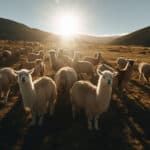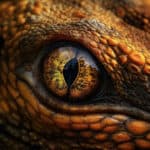The Komodo dragon, scientifically known as Varanus komodoensis, is the largest lizard species in the world. Native to the Indonesian islands of Komodo, Rinca, Flores, Gili Motang, and Padar, these fascinating creatures are known for their impressive size, powerful jaws, and predatory nature. While they primarily feed on a diet of carrion, including deer, pigs, and water buffalo, they are also opportunistic hunters and have been observed preying on smaller animals such as monkeys. In this article, we will explore the intriguing behavior of Komodo dragons when it comes to eating monkeys, shedding light on their hunting techniques, feeding habits, and the ecological significance of these interactions. So, let’s delve into the world of the Komodo dragon and its relationship with its primate prey.
Key Takeaways
- Komodo dragons are known to eat monkeys as part of their diet.
- The powerful jaws and venomous saliva of the Komodo dragon enable it to overpower and consume monkeys.
- This feeding behavior highlights the adaptability and opportunistic nature of Komodo dragons as predators.
The Komodo Dragon: A Brief Overview
A. Origin and Habitat of the Komodo Dragon
The Komodo dragon, scientifically known as Varanus komodoensis, is a fascinating creature that has captured the imagination of people around the world. These carnivorous reptiles are native to the Indonesian islands of Komodo, Rinca, Flores, Gili Motang, and Padar. They are primarily found in the Komodo National Park, a UNESCO World Heritage site.
Komodo dragons inhabit a range of habitats, including tropical forests, savannas, and grasslands. They are well-adapted to the harsh conditions of their environment, with their rugged skin and strong limbs. The islands they call home provide them with a diverse array of prey, including monkeys, deer, birds, and even smaller Komodo dragons.
B. Physical Characteristics and Lifespan
The Komodo dragon is the largest lizard species in the world, with males reaching lengths of up to 10 feet and weighing around 150 pounds. Females are slightly smaller, typically measuring around 7 feet in length and weighing approximately 100 pounds. These impressive creatures have a muscular build, powerful jaws, and sharp, serrated teeth.
Their scaly skin is a mix of gray, brown, and green, allowing them to blend in with their surroundings. Komodo dragons have a long, forked tongue that helps them sense their environment and locate prey. They also have a keen sense of smell, which enables them to detect carrion from miles away.
In terms of lifespan, Komodo dragons can live for up to 30 years in the wild. However, in captivity, they have been known to live even longer, with some individuals reaching their 40s or 50s. This longevity is a testament to their resilience and adaptability.
C. The Komodo Dragon’s Unique Hunting Style
One of the most intriguing aspects of the Komodo dragon is its hunting style. These reptiles are apex predators, meaning they are at the top of the food chain in their ecosystem. While they are capable of ambushing their prey, they are also skilled hunters that employ a combination of stealth, patience, and brute force.
Komodo dragons are opportunistic feeders and have been known to eat a wide range of animals, including monkeys. They have a keen eye for spotting potential prey, and once they have identified a target, they will stalk it silently, using their excellent camouflage to their advantage.
When the time is right, the Komodo dragon will launch a lightning-fast attack, using its powerful legs to pounce on its unsuspecting prey. With its sharp teeth and strong jaws, it delivers a deadly bite, injecting venom into its victim. This venom contains a potent mix of toxins and bacteria that can cause severe infections and ultimately lead to the prey’s demise.
After subduing its prey, the Komodo dragon will feast on its meal. They have a remarkable ability to consume large quantities of food in one sitting, thanks to their expandable stomachs. However, they are not able to digest bones, so they will regurgitate any indigestible parts, such as fur or bones, after their meal.
In conclusion, the Komodo dragon is a remarkable creature with a unique hunting style. Its origin and habitat in the Indonesian islands, along with its physical characteristics and impressive lifespan, make it a true marvel of the animal kingdom. The way it hunts and devours its prey, including monkeys, showcases its predatory prowess and highlights its position as a top predator in its ecosystem.
The Monkey: A Potential Prey
Monkeys are fascinating creatures that inhabit various parts of the world, including the lush rainforests of Indonesia, where the mighty Komodo dragon roams. These primates, known for their agility and intelligence, have a natural habitat and behavior that make them potential prey for the formidable Komodo dragon.
A. The Monkey’s Natural Habitat and Behavior
Monkeys are highly adaptable creatures that can be found in a wide range of habitats, from dense forests to open grasslands. In the case of the Komodo dragon, monkeys primarily reside in the tropical rainforests of Indonesia, including the regions surrounding Komodo National Park.
These primates are social animals, often living in groups called troops. Within these troops, monkeys establish complex social hierarchies and engage in various activities such as grooming, playing, and foraging for food. They are primarily herbivorous, feeding on fruits, leaves, and other plant matter. However, some monkey species also consume insects and small animals when the opportunity arises.
B. Defense Mechanisms of Monkeys
Monkeys have evolved a range of defense mechanisms to protect themselves from predators. One of their most notable features is their agility and speed, allowing them to swiftly move through the treetops and escape potential threats. Their long limbs and prehensile tails provide them with exceptional balance and the ability to navigate even the most challenging terrain.
In addition to their physical capabilities, monkeys also possess keen senses, including excellent eyesight and acute hearing. These senses enable them to detect danger and respond accordingly. When faced with a predator, monkeys may emit warning calls to alert others in the troop, increasing their chances of survival.
C. The Vulnerability of Monkeys to Komodo Dragons
Despite their impressive defense mechanisms, monkeys are not entirely safe from the predatory nature of Komodo dragons. These carnivorous reptiles, known as the largest lizard species in the world, possess a formidable set of hunting skills that make them a significant threat to monkeys and other potential prey.
Komodo dragons are stealthy hunters, capable of patiently waiting for hours to ambush their unsuspecting victims. They rely on their acute sense of smell to detect the presence of prey, including monkeys. Once a Komodo dragon identifies a potential target, it will use its powerful jaws and sharp teeth to deliver a lethal bite.
Furthermore, Komodo dragons possess a venomous bite that contains a potent mix of bacteria. This venom not only weakens their prey but also causes a slow and painful death. Once the monkey succumbs to the venom, the Komodo dragon will devour it, consuming both flesh and bones.
In the wild, the vulnerability of monkeys to Komodo dragons is heightened by the fact that these primates often inhabit the same rainforest ecosystems. As human activities continue to encroach upon their natural habitats, both monkeys and Komodo dragons face increasing challenges for survival.
In conclusion, while monkeys have evolved impressive defense mechanisms, they remain potential prey for the powerful and cunning Komodo dragon. The delicate balance between predator and prey in the rainforests of Indonesia serves as a reminder of the intricate web of life and the importance of preserving these unique ecosystems.
The Predatory Behavior of Komodo Dragons
Komodo dragons, the largest lizard species on Earth, are known for their formidable predatory behavior. These carnivorous reptiles have a diverse diet that includes a variety of prey, one of which is monkeys. In this section, we will explore the hunting strategy of Komodo dragons, the role of stealth and speed in their hunting technique, and the venomous bite that serves as a key weapon in their arsenal.
A. The Hunting Strategy of Komodo Dragons
Komodo dragons are skilled hunters that employ a combination of patience, stealth, and ambush tactics to secure their prey. They are opportunistic predators, constantly on the lookout for potential meals. While they primarily feed on carrion, they are also capable of actively hunting live prey, including monkeys.
When hunting, Komodo dragons rely on their acute sense of smell to detect the presence of potential prey. They can detect the scent of a monkey from a considerable distance, allowing them to pinpoint their target. Once a suitable prey is located, the Komodo dragon will begin its approach, taking advantage of its excellent camouflage to remain undetected.
B. The Role of Stealth and Speed
Stealth and speed are crucial elements of the Komodo dragon’s hunting strategy. These reptiles are remarkably agile and can move swiftly when necessary. When closing in on their prey, they utilize their muscular tails to propel themselves forward, reaching speeds of up to 12 miles per hour (20 kilometers per hour).
As they get closer to their target, Komodo dragons rely on their ability to blend into their surroundings. Their scaly skin, which is a mix of earthy tones, allows them to seamlessly merge with the environment, making it difficult for their prey to spot them. This camouflage, coupled with their silent movements, ensures that they can get within striking distance without alerting their intended meal.
C. The Venomous Bite: A Key Weapon
One of the most fascinating aspects of the Komodo dragon’s predatory behavior is its venomous bite. Contrary to popular belief, it is not the bacteria in their mouths that is responsible for the lethal effects of their bite, but rather the venom they inject into their prey.
Komodo dragons possess venom glands located in their lower jaws, which produce a toxic cocktail of enzymes and proteins. When they bite their prey, the venom is injected into the wound, causing a range of effects, including severe bleeding, paralysis, and a drop in blood pressure. This potent venom incapacitates the prey, making it easier for the Komodo dragon to overpower and ultimately consume it.
It is worth noting that while Komodo dragons are capable of taking down larger prey, such as deer or water buffalo, monkeys are also a part of their natural diet. These agile primates, found in the forests of Indonesia where the Komodo dragon inhabits, provide a nutritious and relatively easy meal for these formidable reptiles.
In conclusion, the predatory behavior of Komodo dragons is a fascinating subject to explore. Their hunting strategy, which involves a combination of stealth, speed, and a venomous bite, allows them to successfully capture and consume a variety of prey, including monkeys. Understanding the intricacies of their predatory behavior sheds light on the remarkable adaptations of these ancient reptiles and their role in the delicate balance of the ecosystem.
The Komodo Dragon’s Diet: An In-depth Analysis
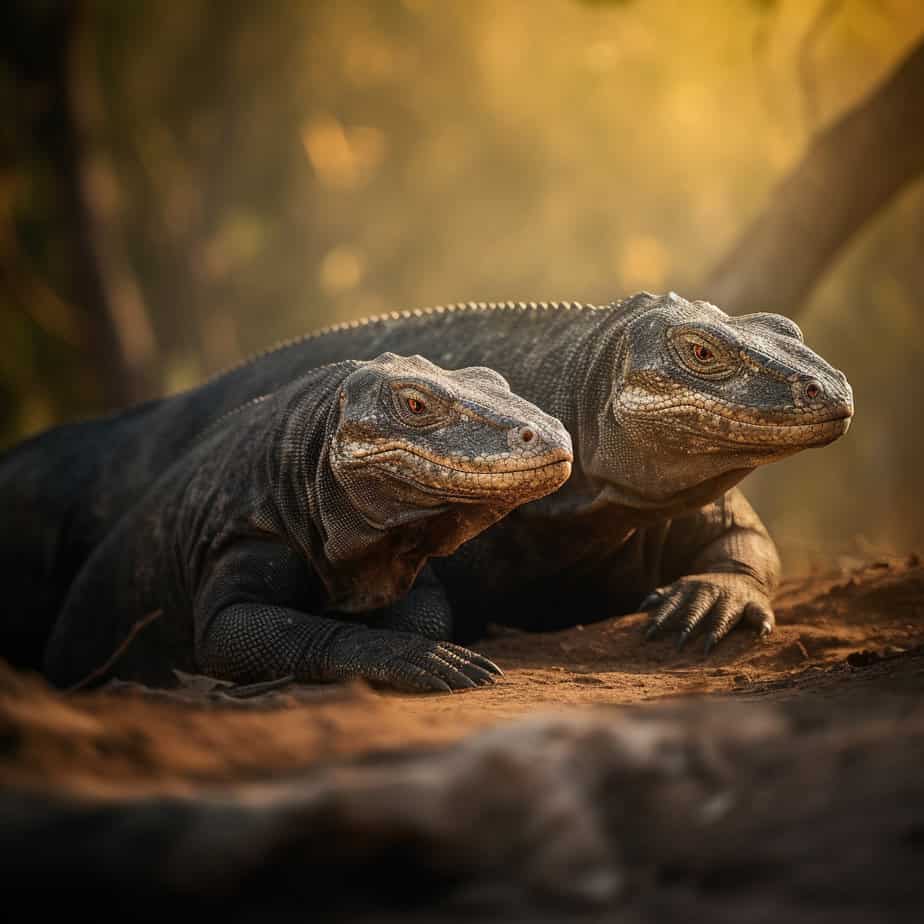
A. The Role of Monkeys in the Komodo Dragon’s Diet
The Komodo dragon, known as the largest lizard species on Earth, is a formidable predator with a diverse diet. While it primarily feeds on small mammals, birds, and reptiles, monkeys also play a significant role in its diet. These carnivorous reptiles are known to inhabit the Komodo National Park in Indonesia, where they coexist with various monkey species.
Monkeys serve as an important food source for Komodo dragons due to their abundance in the region. The monkeys found in the Komodo dragon’s habitat include macaques, langurs, and tarsiers. These primates are agile and quick, making them challenging prey for the Komodo dragon.
B. The Process of Consuming Large Prey
When a Komodo dragon successfully hunts a monkey, the process of consuming the prey begins. Komodo dragons have a unique feeding strategy that allows them to consume large prey efficiently. After overpowering the monkey, the Komodo dragon delivers a powerful bite, injecting venom into the wound.
The venom contains a potent cocktail of toxins that disrupt the monkey’s blood clotting ability and induce shock. This venomous bite weakens the prey, making it easier for the Komodo dragon to overpower and subdue it. Once the monkey is immobilized, the Komodo dragon begins its feast.
Komodo dragons have a flexible jaw and stretchy skin, which enables them to consume prey larger than their own head. They use their sharp, serrated teeth to tear apart the monkey’s flesh, consuming both the meat and bones. The Komodo dragon’s strong digestive system allows it to digest even the toughest parts of the monkey, including hair and nails.
C. The Impact of Diet on the Komodo Dragon’s Lifestyle
The diet of the Komodo dragon has a significant impact on its lifestyle. Being a carnivorous reptile, the Komodo dragon requires a substantial amount of energy to sustain its large size and predatory behavior. Feeding on monkeys provides the necessary nutrients and calories for the Komodo dragon’s survival.
The availability of monkeys in the Komodo dragon’s habitat influences its behavior and hunting patterns. These reptiles have adapted to the presence of monkeys and have developed specific hunting strategies to catch them. They utilize their keen sense of smell and stealthy approach to ambush unsuspecting monkeys, ensuring a successful hunt.
Furthermore, the consumption of monkeys by Komodo dragons has implications for the primate population in the region. As monkeys are an essential part of the Komodo dragon’s food chain, their survival and abundance are crucial for maintaining a balanced ecosystem. The conservation of monkey species in the Komodo National Park is not only vital for their own survival but also for the survival of the Komodo dragon.
In conclusion, monkeys play a significant role in the diet of the Komodo dragon. These carnivorous reptiles have adapted to their environment and developed efficient hunting strategies to catch and consume monkeys. The consumption of monkeys provides the necessary nutrients for the Komodo dragon’s survival and influences its behavior and lifestyle. As such, the conservation of monkey species in the Komodo National Park is essential for maintaining the delicate balance of the ecosystem.
The Ecological Impact of Komodo Dragons Preying on Monkeys
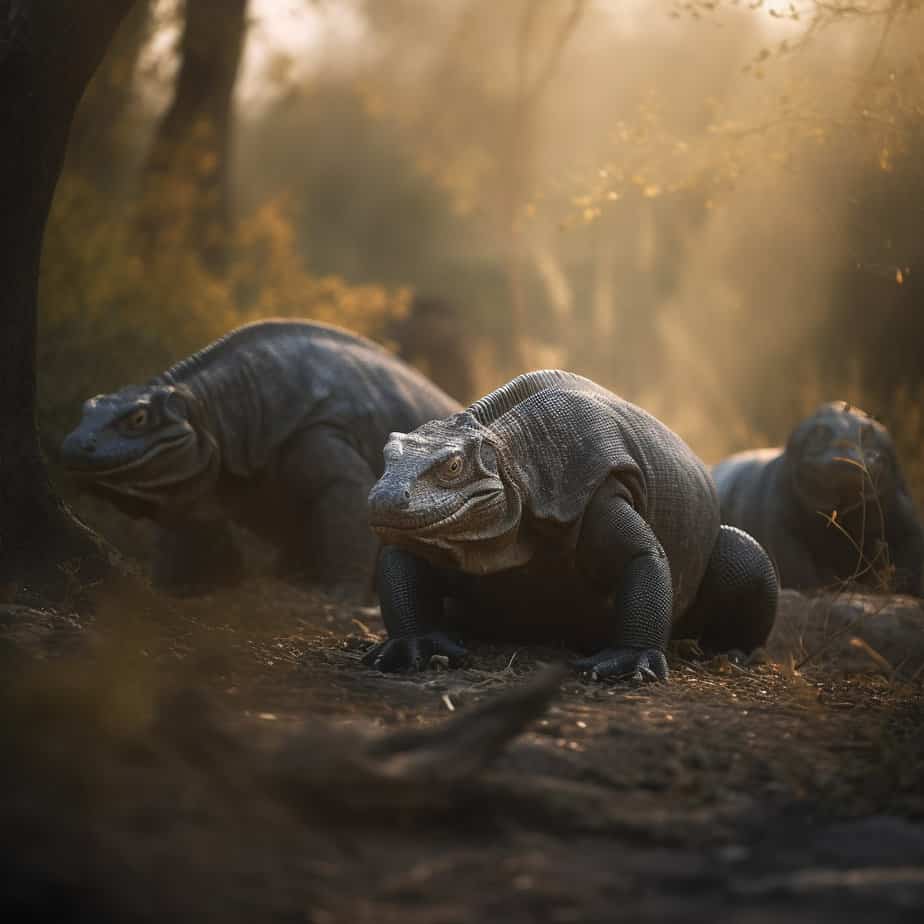
A. The Effect on Monkey Populations
Komodo dragons, the largest lizard species on Earth, are known for their carnivorous behavior and predatory instincts. While they primarily feed on a variety of prey, including deer, pigs, and birds, monkeys are also part of their diet. This raises the question of how the predation of monkeys by Komodo dragons affects monkey populations.
In the wild, monkeys play a crucial role in maintaining the balance of the ecosystem. They contribute to seed dispersal, pollination, and insect control, making them an integral part of the forest ecosystem. However, the presence of Komodo dragons as predators can have a significant impact on monkey populations.
When Komodo dragons prey on monkeys, it can lead to a decrease in their numbers. This can disrupt the natural balance within the ecosystem, as the loss of monkeys can have cascading effects on other species. For instance, if monkey populations decline, there may be an increase in the population of certain insects, which can negatively impact plants and other animals that rely on them.
B. The Impact on the Ecosystem Balance
The predation of monkeys by Komodo dragons can disrupt the delicate balance of the ecosystem. As mentioned earlier, monkeys play a vital role in seed dispersal and pollination. When their numbers decline, the dispersal of seeds becomes less efficient, affecting the regeneration of plant species in the area.
Additionally, the decrease in monkey populations can also lead to an increase in the population of certain plant-eating animals. With fewer monkeys to control their numbers, these herbivores can overgraze on vegetation, leading to habitat degradation and a decline in plant diversity. This, in turn, can impact other species that rely on these plants for food and shelter.
The ecological impact of Komodo dragons preying on monkeys extends beyond just the direct effect on monkey populations. It has the potential to disrupt the intricate web of interactions within the ecosystem, affecting multiple species and their habitats.
C. Conservation Efforts and Their Implications
Recognizing the importance of maintaining a healthy ecosystem, conservation efforts have been implemented to protect both the Komodo dragons and the monkeys they prey upon. One such example is the establishment of Komodo National Park in Indonesia, which serves as a protected area for these species.
Conservation efforts aim to strike a balance between preserving the natural behavior of Komodo dragons and ensuring the survival of monkey populations. By protecting their habitats and implementing measures to minimize human disturbances, these efforts help maintain the delicate ecological balance.
However, conservation efforts can also have implications for local communities and their livelihoods. Balancing the needs of wildlife conservation with the needs of the human population is a complex task. It requires collaboration between scientists, conservationists, and local communities to find sustainable solutions that benefit both the ecosystem and the people who depend on it.
In conclusion, the predation of monkeys by Komodo dragons can have significant ecological implications. It can lead to a decrease in monkey populations, disrupt the balance of the ecosystem, and require careful conservation efforts to ensure the survival of both species. By understanding the ecological impact of Komodo dragons preying on monkeys, we can work towards a more sustainable future for these unique and fascinating creatures.
The Ethological Perspective: Understanding Animal Behavior
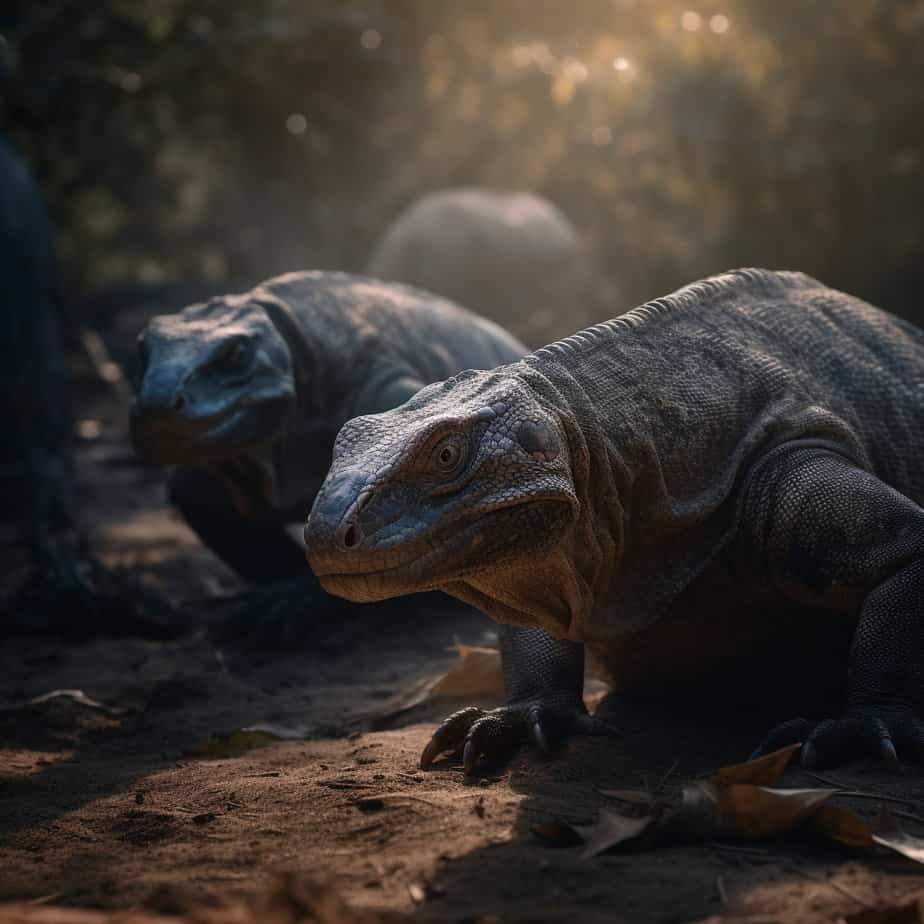
A. The Survival Instincts of Komodo Dragons and Monkeys
When it comes to understanding animal behavior, the survival instincts of different species play a crucial role. In the case of Komodo dragons and monkeys, their instincts are shaped by their respective roles in the food chain.
Komodo Dragons: Apex Predators of the Wild
Komodo dragons, known as the largest lizard species on Earth, are formidable predators. They inhabit the Komodo National Park in Indonesia and have a carnivorous diet. While they are known to consume a variety of prey, including deer and wild boars, monkeys are also on their menu.
Komodo dragons possess powerful jaws filled with sharp, serrated teeth, which they use to tear apart their prey. Their saliva contains a potent mix of bacteria that can cause deadly infections, making their bite even more lethal. These reptiles are known for their stealthy hunting strategies and their ability to patiently wait for the perfect moment to strike.
Monkeys: Prey in the Komodo Dragon’s World
Monkeys, on the other hand, are intelligent and agile creatures that inhabit the same ecosystem as Komodo dragons. They have evolved to be highly adaptable and have developed various survival strategies to avoid becoming prey. However, despite their best efforts, they are not always successful in evading the keen senses and hunting prowess of the Komodo dragon.
B. The Role of Predation in Natural Selection
Predation plays a crucial role in the process of natural selection, shaping the evolution of both predators and prey. The interaction between Komodo dragons and monkeys exemplifies this dynamic relationship.
Komodo Dragons: Evolutionary Adaptations
The predatory behavior of Komodo dragons has influenced their evolutionary adaptations. Their large size, powerful limbs, and sharp teeth are all traits that have developed over time to enhance their hunting efficiency. These adaptations have allowed them to become apex predators in their habitat.
Monkeys: Survival Strategies
For monkeys, survival in the face of predation requires the development of various strategies. They have evolved to be highly agile, with the ability to climb trees and swing from branch to branch. This arboreal lifestyle helps them stay out of reach of predators like the Komodo dragon. Monkeys also rely on their keen senses, such as excellent vision and hearing, to detect potential threats and escape danger.
C. The Interplay Between Fear and Survival
Fear is a powerful emotion that plays a significant role in the survival of both predators and prey. In the context of Komodo dragons and monkeys, fear is a driving force that shapes their behavior and ultimately determines their survival.
Komodo Dragons: Fear as a Hunting Advantage
Komodo dragons instill fear in their prey through their sheer size, aggressive behavior, and deadly bite. This fear response can cause prey animals to freeze or make mistakes, making them easier targets for the Komodo dragon. The element of fear is a crucial aspect of the Komodo dragon’s hunting strategy.
Monkeys: Fear as a Survival Mechanism
For monkeys, fear is a survival mechanism that helps them detect and respond to potential threats. When a monkey senses the presence of a Komodo dragon, fear triggers a cascade of physiological responses, preparing the monkey for fight or flight. This heightened state of awareness allows them to react quickly and increase their chances of survival.
In conclusion, understanding the ethological perspective of animal behavior provides valuable insights into the survival instincts of different species. The interplay between predators like the Komodo dragon and their prey, such as monkeys, showcases the intricate relationship between fear, survival, and natural selection. By studying these dynamics, we can gain a deeper appreciation for the fascinating world of animal behavior. Conclusion
In conclusion, the Komodo dragon’s diet includes a variety of prey, and monkeys are one of the many animals they consume. These large reptiles are opportunistic hunters, and their ability to take down agile and intelligent primates like monkeys is a testament to their strength and adaptability. While it may seem shocking to witness a Komodo dragon devouring a monkey, it is important to remember that this is simply a part of the natural food chain. The Komodo dragon’s hunting techniques, powerful jaws, and venomous bite allow it to successfully capture and consume a wide range of prey, including monkeys. This fascinating behavior highlights the unique and awe-inspiring nature of these ancient reptiles.
Frequently Asked Questions
What is the diet of a Komodo dragon?
Komodo dragons are carnivorous reptiles, meaning their diet primarily consists of meat. They are known to eat a variety of animals, including birds, mammals, and other reptiles. Monkeys are also a part of the Komodo dragon’s diet.
What is the predatory behavior of Komodo dragons?
Komodo dragons are ambush predators. They typically wait in hiding and pounce on their prey when it comes within range. They use their strong jaws, sharp teeth, and toxic saliva to subdue their prey.
How do Komodo dragons hunt?
Komodo dragons have a unique hunting strategy. They rely on their excellent sense of smell to locate prey. Once they have identified a target, they will stalk it patiently before launching a surprise attack.
What are the feeding habits of Komodo dragons?
Komodo dragons are known for their voracious feeding habits. They can eat up to 80% of their body weight in a single meal. Their feeding time is not specific and can happen anytime when they are hungry and find prey.
Are monkeys prey to Komodo dragons?
Yes, monkeys are part of the Komodo dragon’s food chain. They can become prey, especially if they are within the Komodo dragon’s hunting range in the wild.
What is the largest lizard species?
The Komodo dragon is the largest living lizard species. Adult males can reach lengths of up to 3 meters (10 feet) and weigh up to 70 kilograms (154 pounds).
How do monkeys survive in the Komodo habitat?
Monkeys in the Komodo habitat have developed various survival strategies to avoid becoming prey. These include living in groups for protection, staying in trees where Komodo dragons cannot reach, and being vigilant of their surroundings.
Are there endangered primates in the Komodo National Park?
Yes, there are endangered primate species in the Komodo National Park. The park is home to a variety of wildlife, including several species of monkeys that are considered endangered.
What is the role of the Komodo dragon in the food chain?
As apex predators, Komodo dragons play a crucial role in maintaining the balance of the ecosystem. They help control the population of their prey species and remove sick or injured animals, thus contributing to the overall health of the ecosystem.
How does the Komodo dragon’s carnivorous behavior impact other species?
The carnivorous behavior of the Komodo dragon can impact other species in several ways. It can control the population of certain species, thus preventing overpopulation. However, it can also pose a threat to endangered species, such as certain monkey species in Indonesia.

